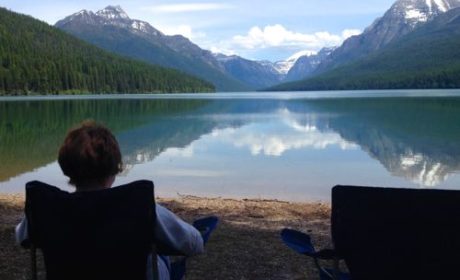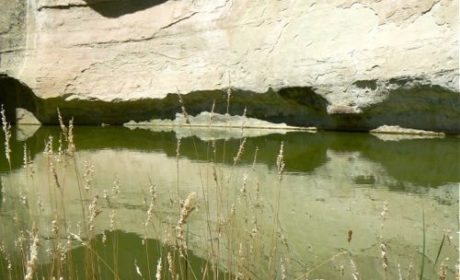Would you like to explore Bighorn Canyon National Recreation Area in Wyoming? Summer is prime time for National Park travel, but getting away from the tourist pack isn’t always easy.
A trip to off-the-beaten-path Bighorn Canyon may be your answer. And it’s every bit as breathtakingly beautiful as the Grand Canyon or Yellowstone.
Guest contributor Teresa Otto is here to share her tips to a truly spectacular destination for anyone who loves wildlife, scenic views and active travel. You’ll find this uncrowded piece of paradise on the border of northern Wyoming and southern Montana in the southern district of Bighorn Canyon National Recreation Area.
Table of Contents
Explore Bighorn Canyon to escape national park crowds

In 2017, Yellowstone National Park hosted four million tourists. Four million folks vying for a front row seat to view Old Faithful geyser. Four million people trying to capture a photo of a bison or bear with no one else in the frame. Four million people. Year after year, the crowds keep increasing.
But if you travel east of crowded Yellowstone, you’ll discover a wonderful area for experiencing the rugged beauty of a tumultuous past, the smell of sagebrush, the sound of echoes bouncing off canyon walls, and the lingering sacredness of ancient people. This unspoiled, untamed land is the Southern District of Bighorn Canyon National Recreation Area (official website).
Located roughly between Billings MT, Sheridan WY, and Cody WY—and still part of the Yellowstone ecosystem—this 188 square mile park welcomed just 250,000 people in 2017. Now that’s elbow room. The quote “Spectacular Views, Endless Opportunity” from Bighorn’s website completely sums up the rewards of visiting.
The view: one of the top five largest canyons in the United States and evidence of the canyon’s early inhabitants.
The opportunity: hiking a trail you have all to yourself, exploring the canyon from a boat or kayak, and seeing wild horses and Bighorn sheep for which the canyon is named.
Begin your boomer travel adventure at the Bighorn Canyon Visitors Center

No matter how you plan to explore, stop at the visitors’ center near Lovell, Wyoming. There you’ll find maps, educational videos, and well-informed park rangers.
Ranger Todd Johnson, whose love of the park is infectious, makes a habit of exploring the park with camera in hand, sharing his knowledge with visitors and commenting on autumn, his favorite season here. “In summer, it’s Old Testament hot. Fall is cooler, leaves are changing and the rams are back.”
On the subject of history, Todd tells the origins of Highway 37 entering the park. This road was originally an animal trail. Ancient people following animals used the same path 10,000 years ago.
Fur traders and European settlers later traversed this dangerous route, aptly named Bad Pass Trail. Now paved, it’s the only road into the Southern District which is eleven miles northeast of Lovell.
Boomer Travel Tip
Start planning your next national park trip with our National Park Travel Planner!
Bighorn Canyon’s best views

The five-million-year-old canyon was created by the upheaval of the Pryor and Bighorn Mountains and eroded by the Bighorn River. Two spots provide the best views of the 38 million years and 1000 feet of layered tan, orange and gray rock that forms the canyon walls.
The first is Devil’s Canyon overlook. If you don’t mind a bit of a scramble, an unmarked, steep, shale path on the south side of the parking lot entrance leads to a view of the iconic arch framing the canyon behind. Exercise caution on this short path.
A mile north of the Devil’s Canyon turnoff, Sullivan’s Knob Trail offers a view of the massive canyon’s grandeur via a moderate 0.75-mile hike. Give a shout-out to the canyon while you’re here. It answers back.
Trekking Through History

Two Eagles Interpretive Trail is a glimpse into the human history of the canyon. Interpretive signs or audio downloads bring the area to life. To walk 10,000-year-old paths among tepee rings is a privilege that could never be enjoyed at an over-crowded park.
Rangers are happy to advise you on the ten additional trails and bear activity. It’s best to make some noise on these remote trails, to bring water, not food, and to carry bear spray (order it here). Other hazards to be aware of are rattlesnakes and poison ivy. Personally, I’d rather run into the ivy.
Boomer Travel Tip
Check out more of our national park travel ideas.
Kayaking in Bighorn Canyon

Bighorn Lake satisfies water-lovers with boating, kayaking, and fishing. The Southern District hosts two marinas—Horseshoe Bend Marina and Barry’s Landing. Horseshoe Bend Marina offers paddle boat rentals and scenic boat excursions during the summer.

Park rangers lead free half-day kayaking tours on Saturdays between June and early September. Paddling in the shadow of the canyon walls offers a unique perspective but makes you feel a bit small.
The park posts these trips (as well as educational events and spectacular photos by Todd Johnson) on their Facebook page. Because spots fill quickly, it’s best to contact the Visitors’ Center for dates and sign up over the phone immediately. The weather-dependent launch site and time are emailed the day before the trip. No experience is needed.

Bighorn Canyon Wildlife
I treasure the wildlife here. Fall is a perfect season to see Bighorn sheep and wild horses as they return to lower elevations after spending summer in the cooler mountains. Bighorn ewes nonchalantly graze at the highway’s edge.

A small group of Pryor Mountain wild horses, nicknamed the “Welcome Herd” often congregate near the entrance of the park. They’re not particularly spooky around people, continuing to groom and nuzzle each other despite an audience. Solo stallions graze throughout the park.

Mule deer and coyotes can often be spotted, too, but you’d be very lucky to see an elusive cougar or bobcat. Birds are abundant with golden eagles, meadowlarks, red-winged blackbirds, bluebirds and great horned owls calling it home.
On a recent Bighorn Canyon visit, I watched a black bear sow and her two cubs foraging near Barry’s Landing. No crowds counting the bears, it was just the three of us.

Finally, the Bighorn River is a fly fisherman’s ‘died and gone to heaven’ place, teeming with rainbow and brown trout. The catch of the day on Bighorn Lake can be walleye, perch, catfish or trout.
The peacefulness of this sacred place makes the trip to the Bighorn Canyon an unforgettable experience. In the words of Crow Chief, Arapooash, ‘“The Crow country…is a good country. The Great Spirit has put it exactly in the right place; while you are in it you fare well; whenever you go out of it, whichever way you travel, you fare worse.”
Boomer Travel Tip
Looking for a national parks books reading list? Here are our recommendations for 52 of the Best National Parks Books.
Plan your trip to Bighorn Canyon
Whether you enjoy sightseeing or fishing, hiking or boating, Bighorn Canyon National Recreation Area will treat you to spectacular views and endless opportunities. Getting here, requires more of an effort than a typical national park trip so follow these tips:
Practical Information:
- Know where to go with the Wyoming Benchmark Road & Recreation Atlas. Includes roads, trails and public land information.
- Entrance to the recreation area is free.
- The park has no gas stations, hotels or motels but does have a snack bar (Horseshoe Bend Marina) and four campgrounds (two are boat/hike-in only). The campgrounds do not accept reservations.
- Limited lodging is available in Lovell, WY. Check here for hotels in Lovell.
- The Northern and Southern Districts are not connected by any roads.
More to see near Lowell, WY:
Or turn this experience into a road trip to include visiting Little Bighorn National Battlefield.
Save to Pinterest




